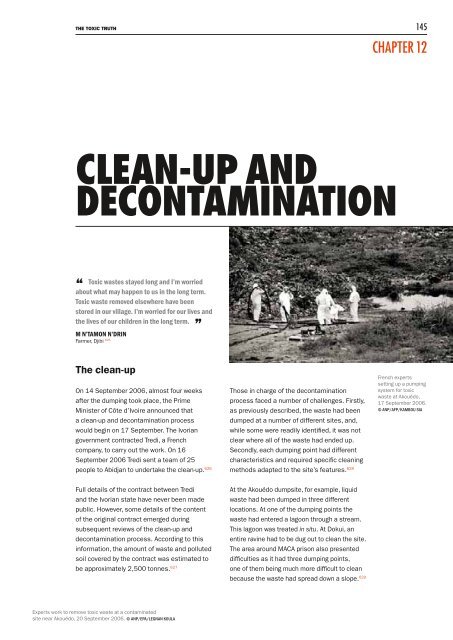the toxic truth - Greenpeace
the toxic truth - Greenpeace
the toxic truth - Greenpeace
You also want an ePaper? Increase the reach of your titles
YUMPU automatically turns print PDFs into web optimized ePapers that Google loves.
<strong>the</strong> <strong>toxic</strong> <strong>truth</strong><br />
Clean-up and<br />
deContamination<br />
“ Toxic wastes stayed long and I’m worried<br />
about what may happen to us in <strong>the</strong> long term.<br />
Toxic waste removed elsewhere have been<br />
stored in our village. I’m worried for our lives and<br />
<strong>the</strong> lives of our children in <strong>the</strong> long term. ”<br />
M N’TaMoN N’DrIN<br />
Farmer, Djibi 625<br />
The clean-up<br />
On 14 September 2006, almost four weeks<br />
after <strong>the</strong> dumping took place, <strong>the</strong> Prime<br />
Minister of Côte d’Ivoire announced that<br />
a clean-up and decontamination process<br />
would begin on 17 September. The Ivorian<br />
government contracted Tredi, a French<br />
company, to carry out <strong>the</strong> work. On 16<br />
September 2006 Tredi sent a team of 25<br />
people to Abidjan to undertake <strong>the</strong> clean-up. 626<br />
Full details of <strong>the</strong> contract between Tredi<br />
and <strong>the</strong> Ivorian state have never been made<br />
public. However, some details of <strong>the</strong> content<br />
of <strong>the</strong> original contract emerged during<br />
subsequent reviews of <strong>the</strong> clean-up and<br />
decontamination process. According to this<br />
information, <strong>the</strong> amount of waste and polluted<br />
soil covered by <strong>the</strong> contract was estimated to<br />
be approximately 2,500 tonnes. 627<br />
Experts work to remove <strong>toxic</strong> waste at a contaminated<br />
site near Akouédo, 20 September 2006. © ANP/EPA/LEgNAN KouLA<br />
Those in charge of <strong>the</strong> decontamination<br />
process faced a number of challenges. Firstly,<br />
as previously described, <strong>the</strong> waste had been<br />
dumped at a number of different sites, and,<br />
while some were readily identified, it was not<br />
clear where all of <strong>the</strong> waste had ended up.<br />
Secondly, each dumping point had different<br />
characteristics and required specific cleaning<br />
methods adapted to <strong>the</strong> site’s features. 628<br />
At <strong>the</strong> Akouédo dumpsite, for example, liquid<br />
waste had been dumped in three different<br />
locations. At one of <strong>the</strong> dumping points <strong>the</strong><br />
waste had entered a lagoon through a stream.<br />
This lagoon was treated in situ. At Dokui, an<br />
entire ravine had to be dug out to clean <strong>the</strong> site.<br />
The area around MACA prison also presented<br />
difficulties as it had three dumping points,<br />
one of <strong>the</strong>m being much more difficult to clean<br />
because <strong>the</strong> waste had spread down a slope. 629<br />
145<br />
Chapter 12<br />
French experts<br />
setting up a pumping<br />
system for <strong>toxic</strong><br />
waste at Akouédo,<br />
17 September 2006.<br />
© ANP/AFP/KAmbou SiA

















